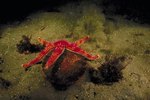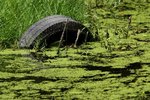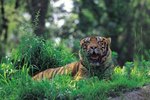An aquatic ecosystem is the way in which living organisms interact within a body of water. Essentially it describes the relationship between plants and animals within an aquatic environment. These systems exist in places such as oceans, ponds, lakes, streams and rivers. Understanding the different components they are made from helps to explain how each one contributes to the survival of the ecosystem and its surroundings.
Layers
Layers in an aquatic ecosystems include the material on the bottom of the water body, most commonly sand, rocks or mud. Next is the water itself, which could be freshwater or saltwater and static or moving. For example a river flows but a swamp is stagnant and does not move. The top layer is the air above the water. This is important because it oxygenates the water and chemicals from the air dissolve in the water and affect its clarity and quality.
Microorganisms
Microorganisms are very small life forms that you cannot see with the naked eye unless in big groups, such as algae or fungi. They exist in large numbers within the ecosystem's layers. Whilst they may cause disease such as dysentery, within an ecosystem they are crucial because they decompose and recycle material to remove polluting matter. If a fish dies, for example it would be toxic to the water if it was not decomposed and disposed of by the microorganisms. Microorganisms also provide nitrogen to regulate the environment for the survival of other organisms.
Macro-organisms
Macro-organisms are the larger things you can see within an aquatic ecosystem. Plants and animals are both macro-organisms. The plants are crucial to the ecosystem for re-oxygenating water and providing a habitat to creatures. Animals are varied in size and type from crustaceans to whales. Similar to other habitats, the animals in an ecosystem have predators and operate according to a natural food chain. For example, plankton eat microorganisms, fish eat plankton, seals eat fish and sharks eat fish. This chain controls population levels.
References
Photo Credits
-
by the pond image by Quennie Chua from Fotolia.com
Writer Bio
Based in Bristol, Philippa Jones has been a music journalist and script writer since 2007, working across a range of radio programs in the U.K. and Australia. Her articles have appeared in "Impact Magazine," "The Mic" and in local newspapers. She holds a Bachelor of Arts in politics from the University of Nottingham.





